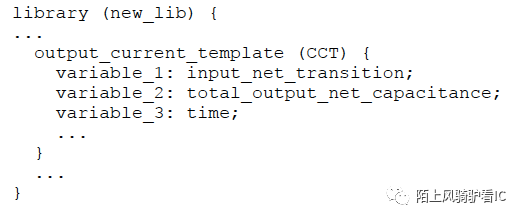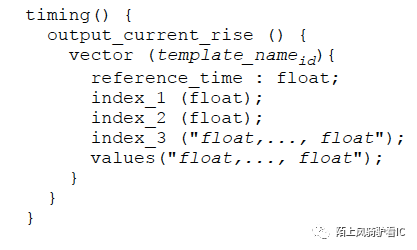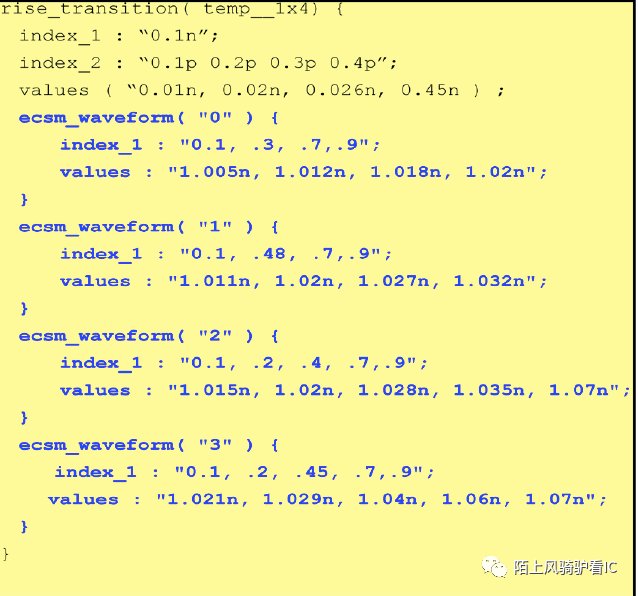看新工艺的library 像看天书一样,多了很多内容,老驴打算挖个坑尝试去读一下lib 中每个表格所代表的意义及用途,今儿开篇。
LDM:
LDM: linear delay model, 最简单的cell delay 模型,计算公式:
D = D0 + D1 * S + D2 * C
其中,D0, D1, D2 是常值,S 是input transition time, C 是output load capacitance.
优点:简单。
缺点:不精确。
现状:已淘汰。
NLDM:
NLDM: Non-Linear Delay model, 在lib 中是几张index 为input transition 跟output load 的二维表,如果是多输入cell 每个输入到输出的delay 跟其他输入的状态相关,在lib 中会用 "sdf\_cond" 跟 "when" 来表示。NLDM 是在仿真波形上采样三个点得到cell delay 跟output transition:
- slew\_lower\_threshold\_pct\_rise/fall, 通常是工作电压的30% 或20%, 用于计算output transition.
- slew\_upper\_threshold\_pct\_rise/fall, 通常是工作电压的70% 或80%, 用于计算output transition.
- input/output\_threshold\_pct\_rise/fall, 通常是工作电压的50%, 用于计算cell delay.
因为NLDM 只采样三个输出点,所以不够精确,尤其是当驱动电阻Rd << Znet 时,所以65nm 之后的工艺需要更精确的模型,比如CCS 跟ECSM.
优点:简单明了。
缺点:不精确,无法模拟miller 效应,无法模拟先进工艺的各种效应。
现状:依旧在使用。
CCS, ECSM
CCS, Composite Current Source, 最早由S 发布,目前由IEEE-ISTO 旗下的LTAB 维护。ECSM,Effective Current Source Model, 最早由C 发布,目前由SI2 旗下的OMTAB \<Open Modeling Technical Advisory Board > 维护。
CCS 跟ECSM 本质上都是电流源模型,能够抽取电路模型,用于静态时序、功耗、噪声和电压降分析,相较于NLDM 模型具有如下优点:
- High-Z interconnect
- Receiver Miller effect
- Dynamic IR-drop
- Multi-voltage, and Dynamic Voltage and Frequency Scaling (DVFS) design
- Driver weakening
- Temperature inversion
- Lithography induced variability
对于如上电流源模型,q=C*V, i = q/t, 所以可得 i * t = C *V. 其中:
\_q=charge stored in capacitor, \_
\_C=capacitance \_
v=voltage across capacitor
\_i=current
\_
所以,可得:
公式一即是CCS 所用的公式,在library 中定义在output\_current\_rise 跟output\_current\_fall 中,有三个index 分别对应:
- input\_net\_transition
- total\_output\_net\_capacitance
- time
公式二是ECSM 所用公式,在library 中定义在ecsm\_waveform\_set 或ecsm\_waveform 中,ecsm\_waveform\_set表中只有一个index 值是电压,表格实际上是一张64*N 列的表格,64 由 input net transition 跟total output net capacitance 决定,N 对应2% -98% 工作电压的采样。新工艺ECSM 推荐使用:
- 8-piece pin capacitances in ECSM timing libraries.
- 2% - 98% ECSM waveform range.
作者:陌上风骑驴
来源:https://mp.weixin.qq.com/s/bXFUJhzg7F\_OSmgED490Gg
作者微信公众号
相关文章推荐
•摸不着的EDA如何卡住了脖子
•探讨 | 功耗应该在哪个corner看?
更多IC设计技术干货请关注IC设计技术专栏。











